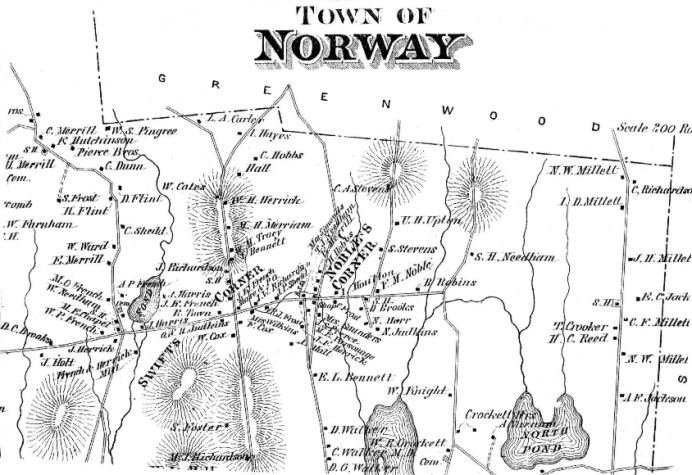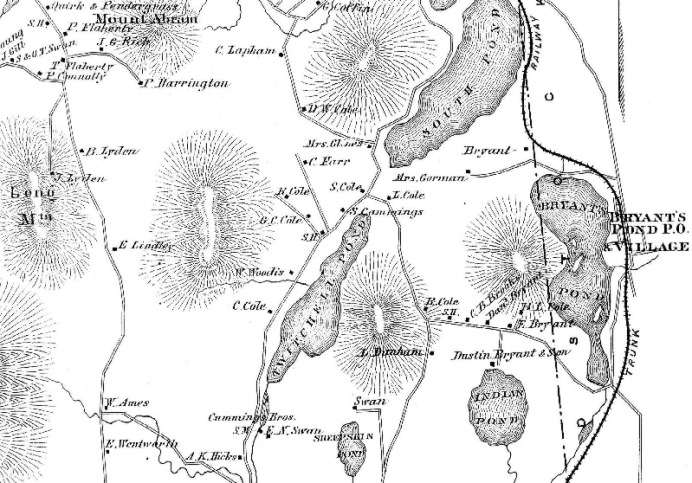Lost in the Woods of Shadagee
Title
Creator
Source
Publisher
Date
Format
Identifier
Text Record
Subjects
Collection
Full Text
Lost in the Woods of Shadagee
by Larry Glatz

The “Shadagee” section of Norway was later known as Noble’s Corner, shown above (center).
From Caldwell & Halfpenny, Atlas of Oxford County, Maine (Philadelphia, 1880).
Practically every county and town in America has its curiously named Slab City, Goon Hollow or Songo Pond. But here in central Oxford County, there are two neighborhoods in nearby towns which share the same puzzling name of Shadagee.
The Shadagee section of Greenwood lies to the south of Locke Mills and on the western shore of Twitchell Pond. At least as early as 1820, by which time the town’s original nine school districts had been formed, the Shadagee designation was in common enough usage to have become attached to District Number Eight school, which was located there.
Ten miles or so to the south of Greenwood’s Shadagee, the town of Norway has a neighborhood which was once known by that same usual name. In the fifty-eighth installment of his newspaper series, "Norway in the Forties," Osgood Bradbury (1828-1897) tells how North Norway’s “Lower Corner” (now known as Noble’s Corner) had once been known as “Shatagee.” Although the North Norway designation is now entirely forgotten, there are enough references to that name and place to suggest that there was a time when all “Norwegians” would have known it as such.
“Shadagee” and “Shatagee” are but two of the numerous spellings of the neighborhoods thus known, but these and all others are phonetically the same. It seems certain, therefore, that unless one of these localities was named after the other, their names had the same original source. However, even if one of the names was “original” and the other “derivative,” the larger question remains. Where did the name come from?

The “Shadagee” section of Greenwood just west of Twitchell Pond is shown in the map above (center).
From Caldwell & Halfpenny, Atlas of Oxford County, Maine (Philadelphia, 1880).
The word "Shadagee," or a near homonyn, does not appear in any dictionary I have seen—not even a dictionary of slang or Americanisms. Although it has a sound not unlike a kind of melding of Shadrach and Galilee, it has no parents or close cousins in the Bible, as far as I can tell. Of course, like so many other local geographical designations, the name might be of Abenaki origin, but Bradbury’s observation that the usage arrived quite late and replaced the very English “North Norway Lower Corner” as the area’s name belies this notion. (Although through the region’s awareness of the tourist trade, more than one very English name has lately disappeared from the map to be replaced by a “more authentic” Abenaki one. The renaming of Canton’s Whitney Pond to Lake Anasagunticook is one nearby example.)
For several years, therefore, “Shatagee,” along with “Yagger,” “Paris Cape” and a few others from here and there in Oxford County remained in my file labeled “Neighborhood Names, Etymology Unknown.” Gradually, however, suggestive evidence accumulated—a scrap of information from one town history, a cursory reference in a journal—enough perhaps to support an educated guess as to the likely origin of Shatagee as a place name in Greenwood and Norway. The story, as I have come to believe, goes like this:
The events and combatants of both the Revolutionary War and the Civil War received considerable attention in our local histories and lore, while from the perspectives of most of our historians, the War of 1812 is often lost in the shadows of its two much more intimidating relatives. However, amid the minutiae and scant local accounts of that war appear details which shed light on the naming of our two Shatagees.
It seems that most of the militia companies which were raised from the towns of Oxford County were assigned either to the defense of Portland or the northern front, from Burlington, Vermont, to Plattsburg, New York, and vicinity. Among the latter soldiers were men of Bethel, Buckfield, Woodstock, Norway, and Paris, serving in the 45th Regiment of Col. Denny McCobb.
In late October 1813, Col. McCobb’s regiment, under the overall command of Gen. Wade Hampton, was involved in an action whose immediate purpose was to secure a staging area on the St. Lawrence which would allow the American forces a means of attacking Montreal. Hampton’s numbers were superior to those of the Canadians who opposed him, and his plan was to advance at nighttime into battle position and attack at dawn. Unfortunately, the American guides were inept, and the ground to be traversed was a dense hemlock swamp. Various detachments became lost and doubled back upon each other, causing their commanding officers to believe that the enemy force was “everywhere.” The confusion was exacerbated by the cleverness of the Canadian colonel, who sent buglers out into various quarters of the woods to sound alarms. The American were baffled into a disorderly rout and were eventually forced to retreat into winter quarters.
Although for obvious reasons the battle was not widely reported to the American press, the Canadians hailed it as a great victory. All in all, it was one of the most ignominious American defeats of the War. This engagement, which would of course be long remembered by the men who fought in it, was named for the dense forest in which it was fought; it became known as the Battle of Chateauguay Woods. But the local lads who returned to Oxford County, being not particularly well schooled in French (even though some of them were Parisians by birth), soon corrupted the name to Shatagee or Shadagee.
Just a few citations from the local histories will serve to support this etymology. In Lapham’s History of Bethel it is reported that Jonathan Bean “was killed in the Shadagee fight, war of 1812 (p. 479). The histories of Paris and Woodstock record the names of several men who “were in the Army of Northern New York” and “were in the engagements of Shadagee and Plattsburg” (Paris, p. 366; Woodstock, p. 112). Charles F. Whitman (1848-1932) tells how Joseph and John Packard had participated in “the battle of Shadagee Woods” and had died of wounds received in that quarter. (History of Buckfield, p. 90.) Moreover, a number of Norway men are listed in Capt. Bailey Bodwell’s company , which served under Col. McCobb at Chateauguay. (Lapham’s History of Norway, p. 236).
In fact, in all of the accounts I have been able to find, the only actions in which area men are said to have been involved during the War of 1812 were the uneventful march to Portland and the remarkably eventful battle of Chateauguay. It seems likely, therefore, that when the veterans returned, there would be some discussion of the defense of the city, but there would be many vivid accounts of the pandemonium which occurred in the hemlock swamps along the Canadian border. Tales of “Shadagee” and its dismal results would undoubtedly be everywhere in the area towns.
Precisely how the name of that northern battle became affixed to the two local neighborhoods will probably never be known, but some reasonable assumption may be made.
Perhaps by 1814 or so, the two areas occupied the “frontier” territory of the towns in which they were located, so those citizens of the more settled areas may have referred to them in the same dismal terms as the veterans were using to describe the New York/Canada frontier. Perhaps the name was first used jokingly by members of one area of the town to make sport of the allegedly undeveloped nature of their neighbors’ lands. Or perhaps veterans settled in those particular locales, which then took on the name of the battle for which the new residents had become known.
In any event, it seems that our local Shadagees got their names from the unusual battle of Chateauguay Woods in which so many of the area militiamen had served. Now, what about “Goon Hollow?”
